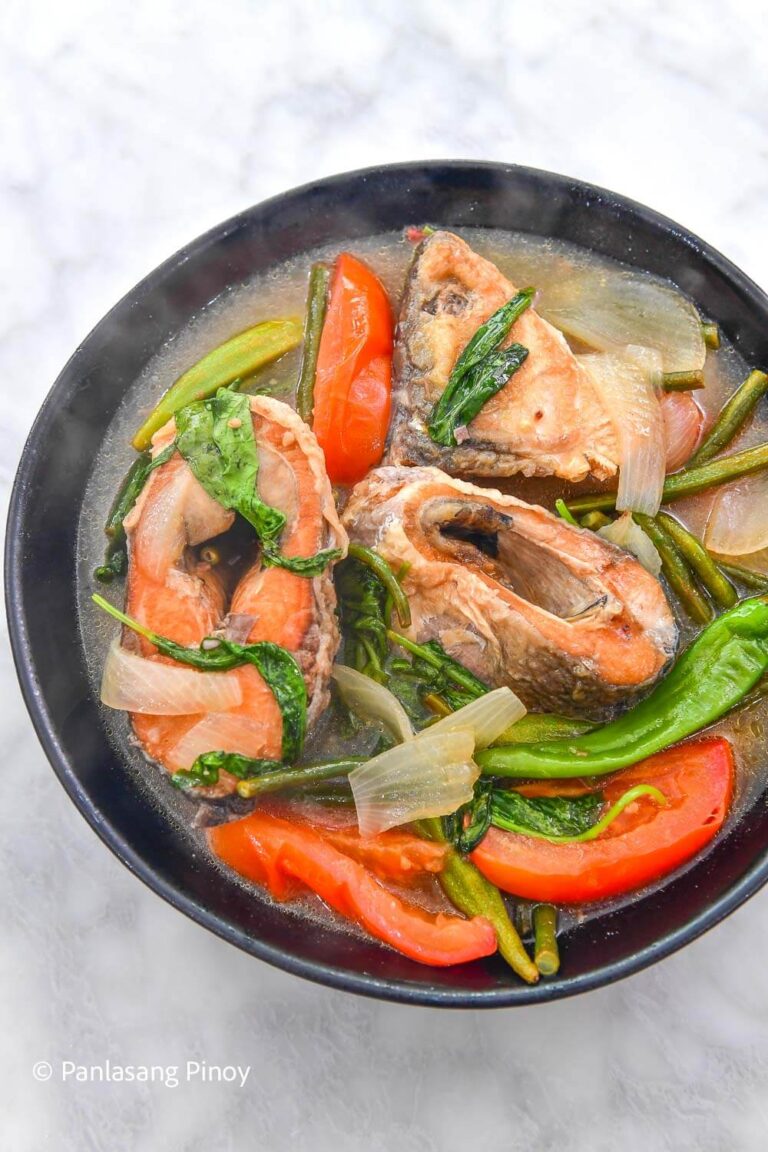Sinigang sa Miso is a type of Filipino sour soup dish. It is a variation of the popular Sinigang. This version features miso paste. Sinigang sa Miso typically includes fish, mixed with vegetables like tomatoes, onions, and leafy greens. The broth is flavored with souring agents, while the miso paste adds a rich taste.
Leave a Comment
Updated: 1/6/25
This post may contain affiliate links. Please read our disclosure policy.
This Sinigang sa miso recipe makes use of miso, a traditional Japanese seasoning made from fermented soybeans, salt and koji (a type of fungus). The miso paste enhances the soup’s flavor by providing umami. This is perfect to have on cold and rainy days.

What is Miso?
The word “miso” came from two Japanese words: “Mi” and “Sho”. The first word means fermented, while “sho” refers to paste. Together, they form miso or fermented soybean paste.
Miso’s addition to Sinigang may have originated from Japanese immigrants arriving in the Philippines in the early 20th century. Aside from adding umami, miso also thickens the broth and provides a creamy texture. Plus, it’s packed with protein, fiber and vitamins, making Sinigang even more nutritious.
How To Cook Sinigang Sa Miso
- Rub salt evenly over the bangus slices. Letting it sit for 10 minutes helps remove excess moisture and enhances its flavor.
- Fry the fish. Heat 3 tablespoons of oil in a pot over medium heat. Fry the fish slices for 1 to 2 minutes per side until lightly browned. Remove and set aside. You’re probably curious why frying the fish is essential. My mother taught me this technique, which locks flavors inside the fish, enhancing the overall taste. I also apply this method in my Pesang Isda with Ginisang Miso recipe.
- Saute the aromatics and simmer the broth. Using remaining oil, sauté onions and half the tomatoes with 2 tablespoons of miso for 2 minutes. This blends flavors and softens vegetables. Next, return the fish to the pot, adding 2 quarts of water. Bring to a boil, then reduce heat to low-medium and simmer for 10 minutes.
- Add the vegetables, season your dish, and serve. Stir in Maggi Magic Sinigang sa Sampaloc. Cook for 2 minutes. Add green peppers, string beans, and okra; stir, cover, and cook for 5-7 minutes. Season with fish sauce and ground black pepper. Stir. Add kangkong leaves, cover, and turn off heat. Let steep 5 minutes. Transfer Sinigang sa Miso to a serving bowl piping hot. It’s flavors are complimented with a condiment of spicy fish sauce (patis). Simply combine fish sauce with crushed chili pepper.


Tips & Tricks
- You can use most fish varieties when cooking sinigang. Bangus, tilapia, king fish, salmon, and tuna are some of the commonly used.
- Sinigang is meant to be sour. Do not go too easy on your souring agent.
- This dish is best served with rice and a condiment of fish sauce with crushed chili pepper.
- Aside from the vegetables used in this recipe, feel free to use the combination of mustard leaves, okra, daikon radish, onion, and tomato.
- Frying the fish before cooking the soup will provide more flavor to the broth.
- Add leafy greens last as these tend to wilt quickly.
How Long Does Sinigang Last in the Fridge?
Sinigang sa Miso typically lasts 3-5 days refrigerated. Store leftovers in a sealed container at 40°F (4°C) or below. Reheat to 165°F (74°C) to ensure food safety—or maintain a rolling boil for 2 minutes. Note that acidity and miso may cause separation, but don’t worry as flavor and texture remain intact. Always check for spoilage signs: off smells, slimy texture or mold growth!


Seafood Sinigang Recipes to Try
Milkfish isn’t everyone’s cup of tea due to its small bones, especially in the tail. Consider these alternative proteins for Sinigang:
- Salmon Sinigang – This Sinigang recipe uses salmon fillet, but you can substitute it with salmon belly or salmon head for added richness.
- Sinigang na Hipon – This is another seafood option you might enjoy. I used fresh shrimp in this recipe.
- Fish Sinigang – Red snapper (maya-maya) makes an excellent substitute for milkfish in sinigang. Follow the same steps: fry the fish, then simmer in warm soup for tender, flavorful results.
- Tuna Jaw Sinigang – Believe it! Tuna panga (tuna jaw) elevates sinigang to new heights. The jaw area’s tender meat is incredibly flavorful!
Pinoys love their S’s: sour, sweet and spicy! Our Sinigang recipe will leave your loved ones “kilig” with its delightful sourness (asim).
Did you make this? If you snap a photo, please be sure tag us on Instagram at @panlasangpinoy or hashtag #panlasangpinoy so we can see your creations!


Sinigang sa Miso
A Filipino fish sour soup enhanced with miso paste.
Instructions
-
Rub salt all over the fish. Let it stay for 10 minutes.
2 teaspoons salt, 2 lbs. bangus milkfish
-
Heat oil in a pot. Fry each side of the fish for 1 1/2 minutes. Remove the fish from the pot and set it aside.
3 tablespoons cooking oil
-
Using the remaining oil, add onion and half of the tomato, and miso. Saute for 2 minutes.
2 tomatoes, 1 yellow onion, 3 tablespoons cooking oil, 2 tablespoons miso
-
Put the fish back into the pot and then pour water. Let it boil.
2 lbs. bangus milkfish, 2 quarts water
-
Cover and cook using low to medium heat setting for 10 minutes,
-
Add Maggi Magic Sinigang sa Sampaloc. Stir. Cook for 2 minutes.
25 g Maggi Magic Sinigang sa Sampaloc
-
Add long green pepper, string beans, and okra. Stir. Cover and cook for 5 to 7 minutes.
12 string beans, 4 pieces long green pepper, 10 okra
-
Add fish sauce and ground black pepper. Stir.
Fish sauce and ground black pepper to taste
-
Put the kangkong leaves into the pot. Cover the pot and turn the heat off. Let it stay for 5 minutes.
1 bunch fresh kangkong leaves
-
Transfer to a serving bowl. Serve.
-
Share and enjoy!
Notes
Miso paste typically comes in white, yellow, red or brown colors (if stored in hot places). You can find it in most Asian grocery stores or the international section of supermarkets. Choose white or yellow miso as these lighter varieties suit Sinigang sa Miso’s flavor. Store miso paste in the refrigerator to keep it fresh.
Nutrition Information
Calories: 1458kcal (73%) Carbohydrates: 42g (14%) Protein: 193g (386%) Fat: 60g (92%) Saturated Fat: 9g (45%) Polyunsaturated Fat: 16g Monounsaturated Fat: 32g Trans Fat: 0.2g Cholesterol: 454mg (151%) Sodium: 6518mg (272%) Potassium: 4057mg (116%) Fiber: 12g (48%) Sugar: 17g (19%) Vitamin A: 3459IU (69%) Vitamin C: 78mg (95%) Calcium: 343mg (34%) Iron: 8mg (44%)




